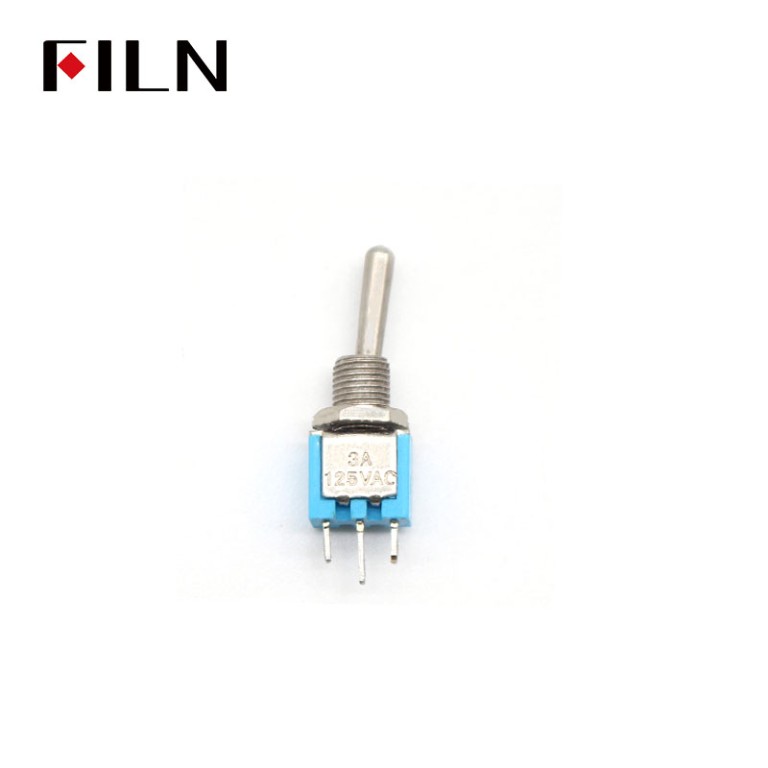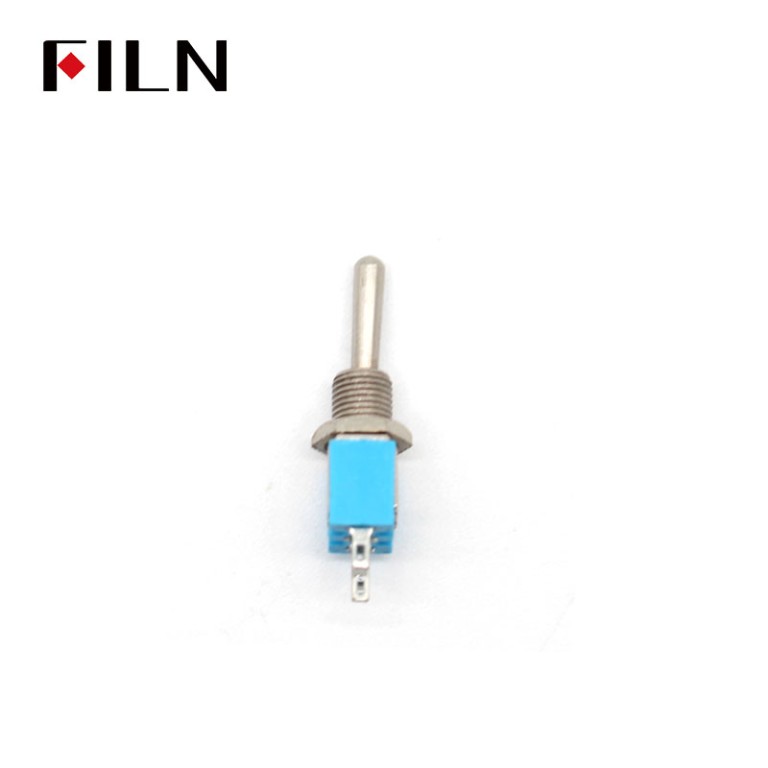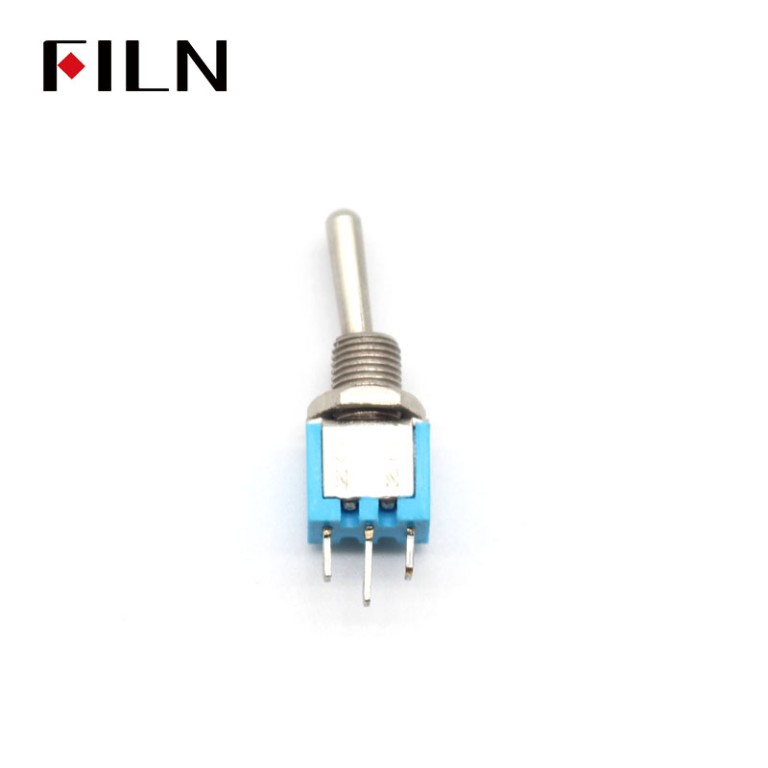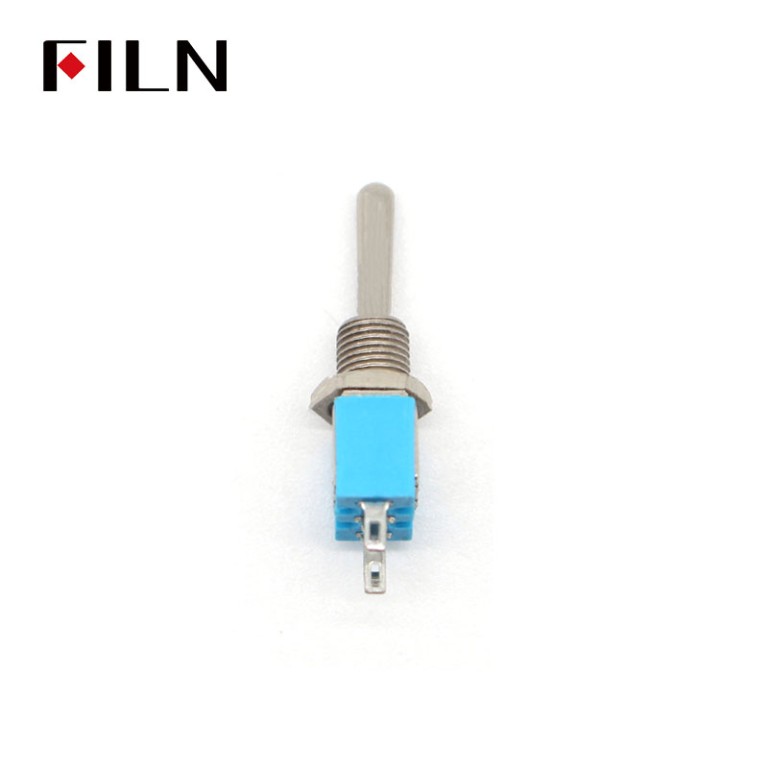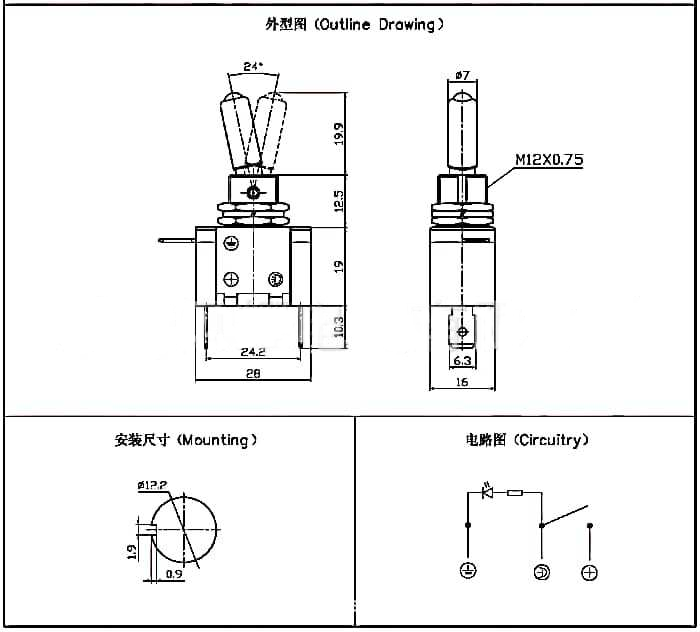An In-Depth Guide to Mini Toggle Switches
An In-Depth Guide to Mini Toggle Switches
- Model:2 prong 12v Toggle Switch
- Name:mini toggle switch
- Working Voltage: < 250V
- Electric Current:20A
- Contact:Open/Closed
- Voltage:250V
- Life:50000 times
- Specifications: 2 pin 2 positions
- Email:inquiry@cnylin.com.cn
- Website:www.FILN.com
Navigating the world of switches can be a complex task, with many types and functionalities to consider. From mini toggle switches to dpdt on-off-on switch schematics, mini rocker switches, 3pdt toggle switches, toggle switch 4pdt, and mini switch buttons, this comprehensive guide explores the nuances of each type, their applications, and key considerations. Whether you’re an industry professional, a DIY enthusiast, or simply curious about the inner workings of these essential components, you’ll find a wealth of information here that demystifies the topic. Dive in to discover how to select, wire, and utilize these switches to their full potential, and learn to avoid common mistakes that could hinder your project’s success.
Table of Contents
Step 1: 10 Most Asked Questions about Mini Toggle Switches
1. What is a mini toggle switch, and what are its common applications?
2. How do mini toggle switches differ from standard toggle switches?
3. What are the different types of mini toggle switches available?
4. How does the DPDT on-off-on switch schematic work within mini toggle switches?
5. How do you wire and install a mini toggle switch?
6. Can you use a mini toggle switch as a mini on/off switch?
7. What are the specifications to consider when buying a DPDT or 3PDT toggle switch?
8. How does a toggle switch 4PDT function, and where is it typically used?
9. How can I select the right mini rocker switches for my application?
10. Where can I buy quality mini toggle switches and related products?
Step 2: What is a Mini Toggle Switch, and What Are Its Common Applications?
Definition of a Mini Toggle Switch
A mini toggle switch is a small electrical switch with a lever or bat that can be moved back and forth to open or close an electrical circuit. This type of switch is often used in electronics and industrial applications.
Common Applications
Mini toggle switches are widely used in applications where space is limited. They are commonly found in:
1. Automotive Controls: For lights, wipers, etc.
2. Musical Instruments: For controlling sound effects.
3. Home Appliances: For on/off functions in devices like fans.
4. Industrial Machinery: To control various machine operations.
5. Consumer Electronics: In devices like radios and remote controls.
Advantages Over Regular Toggle Switches
Mini toggle switches provide:
1. Space Efficiency: Their compact design saves valuable space.
2. Precision Control: Accurate switching for specific tasks.
3. Cost-Effectiveness: Often more affordable than larger switches.
4. Ease of Installation: Simple to install and replace.
Available in Various Forms
Mini toggle switches come in different forms, such as:
1. SPDT (Single Pole Double Throw)
2. DPDT (Double Pole Double Throw)
3. 3PDT (Triple Pole Double Throw)
4. 4PDT (Quad Pole Double Throw)
Each type serves specific needs and applications, with DPDT being one of the most commonly used.
Popular Brands and Suppliers
Several brands and suppliers specialize in mini toggle switches, offering various options. Here are some popular options:
1. [Indicator Light](https://www.indicatorlight.com/category/toggle-switch/): They offer a comprehensive range of toggle switches.
2. Brand X: Known for quality and innovation.
3. Brand Y: Offers customized solutions for unique needs.

Step 3: How Do Mini Toggle Switches Differ from Standard Toggle Switches?
Size Difference
Mini toggle switches, as the name suggests, are smaller than standard toggle switches. This size difference often makes them more suitable for applications where space is limited.
Functionality Comparison
1. Mini Toggle Switches: Typically used for simpler functions, requiring fewer connections.
2. Standard Toggle Switches: Often used for more complex functions, with more connection options.
Different Types
Mini toggle switches come in specialized types such as DPDT, 3PDT, and toggle switch 4PDT, while standard toggle switches might not have these specific variations.
Installation Considerations
Mini toggle switches may have different mounting and wiring requirements compared to standard toggle switches, reflecting their unique design and functionality.
Cost Factors
Mini toggle switches are often more affordable than their standard counterparts, reflecting their smaller size and simplified design.
Availability and Selection
Both mini and standard toggle switches are widely available, but mini toggle switches might offer more specialized options for specific needs, such as micro toggle switch and mini rocker switches.
Application Suitability
1. Mini Toggle Switches: Best for compact devices, consumer electronics, and areas with space constraints.
2. Standard Toggle Switches: Suitable for industrial applications, larger machinery, and areas where size is not a critical factor.
Durability and Performance
While both types of switches offer reliable performance, differences in materials, construction, and design can affect the longevity and effectiveness of mini and standard toggle switches.
Step 4: What Are the Different Types of Mini Toggle Switches Available?
SPDT (Single Pole Double Throw) Mini Toggle Switches
SPDT mini toggle switches are versatile and commonly used in applications where one input needs to switch between two outputs.
DPDT (Double Pole Double Throw) Mini Toggle Switches
DPDT mini toggle switches allow two inputs to switch between two corresponding outputs. They are often used in complex circuits, and a DPDT on-off-on switch schematic is frequently employed.
3PDT (Triple Pole Double Throw) Mini Toggle Switches
3PDT mini toggle switches are used in applications that require three inputs to switch between three corresponding outputs.
4PDT (Quad Pole Double Throw) Mini Toggle Switches
4PDT mini toggle switches are used for more complex applications that require four inputs to switch between four corresponding outputs.
Micro Toggle Switches
Micro toggle switches are even smaller than standard mini toggle switches and are used in highly compact applications such as handheld devices.
Mini Rocker Switches
Mini rocker switches are a variation of mini toggle switches that use a rocking motion rather than a toggling motion.
Mini On/Off Switches
These are simple on/off switches that are used to control power supply in various applications.
Specialized Variants
There are specialized mini toggle switches designed for specific needs, such as waterproof, dust-proof, or those with unique electrical ratings.
Step 5: How Does the DPDT On-Off-On Switch Schematic Work Within Mini Toggle Switches?
Introduction to DPDT On-Off-On Switch Schematic
The DPDT (Double Pole Double Throw) on-off-on switch schematic is a configuration that allows a switch to control two separate circuits or devices. The “on-off-on” refers to the three positions the switch can take: two “on” positions and a central “off” position.
Understanding the DPDT Configuration
1. Double Pole (DP): Refers to the switch controlling two separate circuits simultaneously.
2. Double Throw (DT): Allows each pole to be connected to one of two terminals.
How It Works
The DPDT on-off-on switch schematic can be described as:
1. On Position 1: Connects Pole A to Terminal 1 and Pole B to Terminal 3.
2. Off Position: Disconnects both poles from all terminals.
3. On Position 2: Connects Pole A to Terminal 2 and Pole B to Terminal 4.
Applications of DPDT On-Off-On Switch Schematic
This configuration is used in various applications:
1. Motor Control: To reverse the direction of motors.
2. Sound Equipment: For controlling sound effects.
3.Industrial Machines: To control different operational modes.
Wiring a DPDT On-Off-On Switch
Wiring a DPDT on-off-on switch requires careful consideration of the connections. Proper labeling and following the manufacturer’s instructions can simplify the process.
Advantages of Using DPDT On-Off-On Switch Schematic
1. Versatility: Suitable for controlling multiple devices or circuits.
2. Space Efficiency: Combines the functionality of multiple switches into one.
3. Cost-Effectiveness: Reduces the need for multiple switches, saving money.
Considerations When Selecting a DPDT On-Off-On Switch
1. Electrical Ratings: Ensure compatibility with the intended application.
2. Quality: Choose a reputable brand or supplier, like [Indicator Light](https://www.indicatorlight.com/category/toggle-switch/), for reliable performance.
3. Installation Requirements: Consider the available space and mounting options.
Step 6: How Do You Wire and Install a Mini Toggle Switch?
Understanding the Mini Toggle Switch Configuration
Before wiring a mini toggle switch, it is essential to understand its configuration, such as SPDT, DPDT, 3PDT, or toggle switch 4PDT. Each type has a specific wiring pattern.
Tools and Materials Needed
1. Mini Toggle Switch: Choose the appropriate type for your application.
2. Wires: Select the proper gauge and type.
3. Soldering Iron: For securing connections, if necessary.
4. Screwdriver: For mounting the switch.
5. Wire Strippers: For preparing the wires.
Step-by-Step Wiring Guide
1. Turn Off Power: Always disconnect power before working on the wiring.
2. Prepare Wires: Strip the insulation and prepare the wires.
3. Connect Wires to Switch: Follow the schematic for the specific type of mini toggle switch.
4. Secure Connections: Solder or use connectors as needed.
5. Mount the Switch: Secure it to the panel or enclosure.
6. Test the Switch: Reconnect power and test the switch to ensure proper operation.
Troubleshooting Tips
If the mini toggle switch is not functioning as expected:
1. Check Connections: Ensure all wires are securely connected.
2. Verify Wiring Pattern: Confirm that the wiring follows the correct schematic.
3. Inspect for Damage: Look for any signs of wear or damage to the switch.
Step 7: Can You Use a Mini Toggle Switch as a Mini On/Off Switch?
Understanding the Mini On/Off Switch Function
A mini on/off switch is a specific type of mini toggle switch that functions solely to turn a device or circuit on or off. It’s a straightforward application but has specific considerations.
Wiring a Mini On/Off Switch
1. Selecting the Switch: Choose an SPST (Single Pole Single Throw) mini toggle switch for simple on/off functions.
2. Wiring Connections: Connect one terminal to the power source and the other to the device or load.
3. Mounting: Secure the switch to the desired location.
Applications of Mini On/Off Switches
Mini on/off switches are used in various applications:
1. Small Appliances: Like hairdryers, fans, etc.
2. Electronic Projects: For controlling individual components.
3. Lighting: To control lights in tight spaces.
Benefits of Using Mini On/Off Switches
1. Simple Operation: Easy to understand and use.
2. Compact Size: Ideal for space-constrained applications.
3. Cost-Effective: Typically less expensive than more complex switches.
Customization Options
Many manufacturers, including [Indicator Light](https://www.indicatorlight.com/category/toggle-switch/), offer mini on/off switches with customization options such as color, shape, or specific electrical ratings.
Step 8: What Are the Specifications to Consider When Buying a DPDT or 3PDT Toggle Switch?
Understanding DPDT and 3PDT Toggle Switches
DPDT and 3PDT toggle switches are used to control multiple devices or circuits simultaneously. Understanding their specifications is vital for selecting the right switch for your application.
Key Specifications for DPDT and 3PDT Toggle Switches
1. Electrical Rating: Voltage and current capacity of the switch.
2. Number of Poles and Throws: DPDT has two poles and two throws, while 3PDT has three poles and two throws.
3. Mounting Style: Panel mount, PCB mount, etc.
4. Terminal Type: Screw, solder, quick connect, etc.
5. Switching Function: On-On, On-Off-On, etc.
6. Environmental Ratings: Resistance to dust, moisture, etc.
7. Material: Body and contact material for durability.
Customization Options
Some suppliers, like [Indicator Light](https://www.indicatorlight.com/category/toggle-switch/), offer customization options for DPDT and 3PDT toggle switches to meet specific needs.
Step 9: How Does a Toggle Switch 4PDT Function, and Where Is It Typically Used?
Understanding the Toggle Switch 4PDT
A toggle switch 4PDT (Quad Pole Double Throw) is a complex mini toggle switch with four poles and two throws. It enables control over four separate circuits simultaneously.
Functioning of a Toggle Switch 4PDT
1. Four Poles: Allows connection to four independent circuits.
2. Two Throws: Enables switching between two different paths for each pole.
3. Common Usage: Ideal for complex switching requirements.
Wiring a Toggle Switch 4PDT
1. Understanding the Schematic: Each pole has two throws, so proper understanding of the schematic is crucial.
2. Wiring Connections: Following the correct wiring pattern ensures successful operation.
3. Testing: Verify the connections and test for proper functioning.
Typical Applications of Toggle Switch 4PDT
Toggle switch 4PDT is used in:
1. Industrial Control Systems: Managing multiple processes or devices.
2. Audio Equipment: For routing signals between different components.
3. Complex Electronic Circuits: Enabling intricate control functions.
Advantages of Using Toggle Switch 4PDT
1. Versatility: Controls four circuits simultaneously.
2. Space Efficiency: Combines multiple switches into one.
3. Customization: Options for specific requirements are available.
Considerations When Buying a Toggle Switch 4PDT
1. Specifications: Assess the electrical ratings, material, mounting style, etc.
2. Quality: Opt for quality brands like [Indicator Light](https://www.indicatorlight.com/category/toggle-switch/) for reliability.
3. Price: Balance cost with required features and quality.
Step 10: How Can You Differentiate Between Mini Toggle Switches, Mini Rocker Switches, and Other Types of Switches?
Understanding Mini Toggle Switches
Mini toggle switches are compact switches commonly used for simple on-off or more complex switching functions. They have a lever that is toggled between positions.
Recognizing Mini Rocker Switches
Mini rocker switches operate with a rocking motion rather than a toggle. They are often used for basic on-off functions and have a distinct appearance.
Comparing Mini Toggle and Mini Rocker Switches
1. Appearance: Mini toggle switches have a lever, while rocker switches have a flat or curved actuator.
2. Functionality: Both can serve similar functions but may have different electrical specifications.
3. Size: Both are available in compact sizes, suitable for space-constrained applications.
Other Types of Switches
1. Push-Button Switches: Actuated by pushing, often used for momentary functions.
2. Slide Switches: Slides between positions, used in electronic devices.
3. Rotary Switches: Turned to select different options, used in applications like fan speed control.
Choosing the Right Type of Switch
1. Understand the Requirements: Assess the specific needs of your application.
2. Compare Specifications: Look at electrical ratings, size, mounting options, etc.
3. Consider Aesthetics and Ergonomics: Choose a style that fits the design and user experience.
Customization and Supplier Options
Consider suppliers like [Indicator Light](https://www.indicatorlight.com/category/toggle-switch/) that offer customization options and a wide range of switch types to find the perfect fit for your project.
Step 11: What Are the Key Considerations When Buying a Mini Switch Button?
Understanding Mini Switch Buttons
Mini switch buttons are small push-button switches often used in electronic devices and projects. They provide momentary or maintained actuation depending on the design.
Key Considerations When Buying Mini Switch Buttons
1. Functionality: Determine whether a momentary or maintained switch is needed.
2. Electrical Ratings: Match the voltage and current specifications to the application.
3. Mounting Options: Panel mount, PCB mount, etc.
4. Material: Consider the body and contact material for durability.
5. Aesthetics: Color, shape, and design may be important for the overall look of the product.
Typical Applications of Mini Switch Buttons
Mini switch buttons are used in:
1. Remote Controls: For momentary control of various functions.
2. Small Appliances: Like coffee makers, blenders, etc.
3. DIY Electronics Projects: Suitable for hobbyists and makers.
Benefits of Using Mini Switch Buttons
1. Compact Design: Ideal for small devices or space-constrained applications.
2. Versatility: Available in various styles and configurations.
3. Cost-Effective: Generally affordable, especially in bulk.
Customization Options
Suppliers like [Indicator Light](https://www.indicatorlight.com/category/toggle-switch/) offer customization options, such as specific colors or shapes, to match the requirements.
Conclusion
By understanding the various types and applications of mini toggle switches, including mini rocker switches, dpdt on-off-on switch schematics, mini on/off switches, dpdt toggle switches, 3pdt toggle switches, toggle switch 4pdt, and mini switch buttons, one can make informed decisions for both industrial and personal projects. From wiring considerations to customization options, paying attention to details ensures successful implementation and reliable performance. Whether you are a hobbyist or a professional, considering these factors can lead to a successful project or product.





